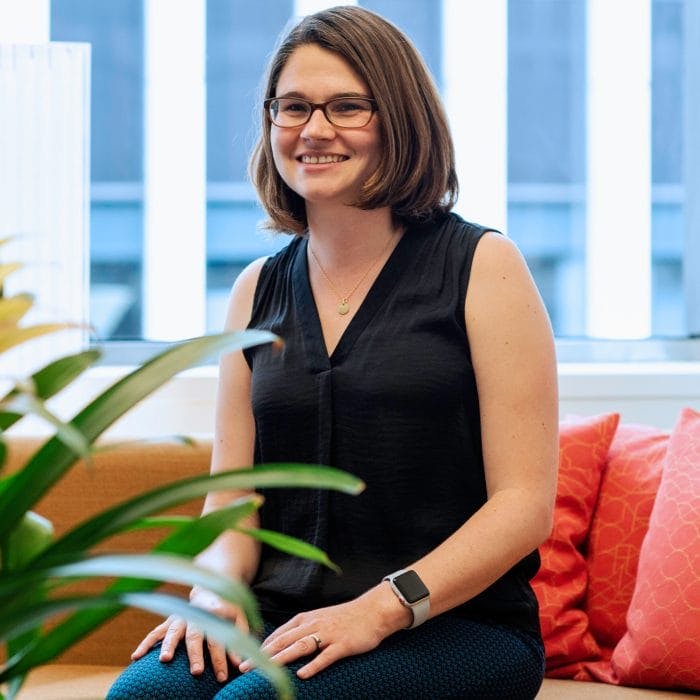I can’t stop thinking about lightning.
I spent the better part of a decade studying the neuroscience of human motivation before launching my career out of academia and into digital health. I was committed to the focus of my work, but I’ll admit – I was restless.
Now I find myself sitting between researchers, academics, and scientists on one side, and designers, engineers, and product managers on the other—discussing how to build products that bring design, engineering, and science together. I’ve seen how these messy conversations are going down in all sorts of rooms, from small start-ups to Apple health special projects to the nonprofit world at Hopelab. I realize now as I look back at where I started that academia wasn’t just the locus of my work, it was a lens through which I saw possibility.
One day I was sitting in a meeting at a tech company, discussing what makes a good product. I was pushing the agenda of bringing motivational science to product design and the other person asked, rhetorically, “who knows more about human motivation – Facebook or the academics?” The person asking was a scientist himself, a bonafide academic, but here he was asserting as a given that Facebook is the authority on human motivation.
Not long after this meeting, I was talking to a colleague about the pace of behavior change. Like a good psychologist he was pointing out that behavior change takes time, people aren’t always ready to change and we can’t expect change to happen quickly. I held up my iPhone and asked – “How many behaviors have you changed practically overnight just because of this tool?” Indeed, fundamental human behaviors of communication, navigation, nutrition, and productivity have changed in the blink of a researcher’s eye with changing technology. Put another way, I didn’t need a phased intervention to stop using a paper map and start using a GPS app; the innovation was the intervention.
But wait a minute – something’s missing here. There’s a bigger picture than targeting isolated bits of behavior and motivation like throwing darts at balloons. What we want is for people to be living healthier lives, lives that are aligned with their values and their well-being. So what happens when we shift the question from “how do we use tech to change behavior” to “how do we build tech products that promote well-being?” And, just as importantly, “how do we build well-being products that effectively use technology?”
Because here’s what I know. Tech products are essential to the future of human connection and functioning, with a potential for impact that is both vast and intimate. Academic research, meanwhile, is essential to advancing the rigorous inquiry of our messiest, most mysterious humanity. Tech sees what people do and reverse engineers the decision-making process, with huge N’s and algorithms and massive statistical power and, ultimately, an accuracy that you know is good because it translates to dollars. Academia continually monitors the ethics of evaluating human behavior and seeks to understand complex behavior as an end in itself. I don’t just appreciate these approaches, I believe in them. I believe in them each, uniquely.
The thing about lightning is that it’s just tension at great heights. The opposing charges get stronger and stronger until – CRACK! Something spectacular happens.
What we’re really looking for here is not a resolution on who does it better, but a way for people with different perspectives to work together. We’re looking for the interlocking pieces, where we can free the strengths of each approach from their silos and create something that has been, up to this point, unimaginable. Why can’t academics harness the motivational, catalytic draw of successful tech products at scale? And why can’t tech products adopt ethical and evidence-based practices to implement change for good?
They can.
There are three main areas that need to be addressed to make better products that people actually use to make their lives better. Those areas are:
#1 the professional cultural divide between thought-based-science and action-based-development that insidiously breaks down collaboration.
#2 the application of modern software tools for the purpose of measuring efficacy.
#3 the development of fast proximal indicators that can be linked to long term health outcomes.
An organization that wants to make serious tech products for serious good needs to build proficiencies in each of these areas in order to achieve and then maintain these standards long term.
Stephanie Greer, Hopelab’s former Research Lead, is a curious and creative thinker with a diverse skill set in behavioral neuroscience, design, and digital product development. Prior to Hopelab, Stephanie earned her Ph.D. in neuroscience studying health decision making (including sleep and dieting behavior) and was an early member of the Health Special Projects team at Apple. She is currently on sabbatical, gleaning knowledge from cultures around the world.





